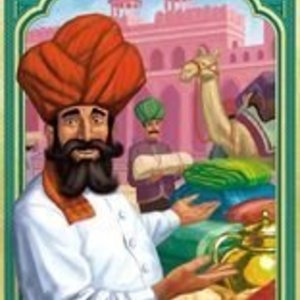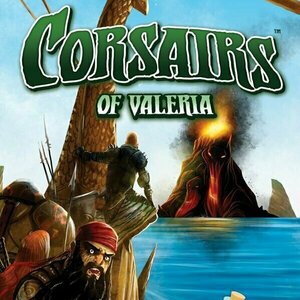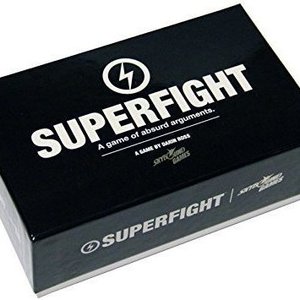Purple Phoenix Games (2266 KP) rated Cryptocurrency in Tabletop Games
Apr 2, 2020
You are the CEO of a fin-tech startup company. Leading a team of specialized experts, you will evaluate, trade, and mine different cryptocurrencies. Strategy is key, as you must stay ahead of the trend to maximize your earnings from the market. Can you solve the right algorithms and manipulate the network to help create the most wealth for your company? Or will you be scammed into buying worthless cryptocurrency? Play to find out!
Disclaimer: We were provided a copy of this game for the purposes of this review. This game is available to purchase, so the components seen in the pictures are what come with the game. I do not intend to rehash the entire rulebook in this review, but rather provide the basic ruleset and general gameplay overview of the game. Feel free to pick up a copy of the game directly from the publisher or your FLGS! -L
Cryptocurrency is a game of commodity speculation, action points, trading, and a little push your luck in which players are trying to amass the most amount of money over 5 rounds. To setup the game, place the Cryptocurrency Info Boards in the center of the play area, and place the Market Board next to them. Prepare and distribute the Rumor cards, and create the Ongoing Transactions deck. Each player receives a player reference card, 3 Intern Expert cards, and a total of 6 Wonga (the currency of the game). The game is now ready to begin! Each round is broken up into 4 phases: Prep, Action, Upkeep, and Rumor. During the Prep phase, each player (in turn order) must draw a Rumor card, and may hire a new Expert or take a loan. Experts are hired (purchased) from the Job Seekers pile, and often provide special abilities or increased Action Points. Hired Experts must replace one Expert from their existing team. Your team can only have 3 Experts, so choose wisely who to hire and fire! A loan can be taken to immediately gain 8 Wonga, but interest must be paid for the loan later in the round. After each player has performed these actions, play moves to the second phase.
During the Action phase, players take turns performing one of two actions: Mining or Trading. These actions are performed by spending Action points – each Expert offers a certain number of points to spend. Once you use an Action Point, that Expert is exhausted and can no longer work in this phase. To Mine, players choose one of the 4 available cryptocurrencies to mine (research), and will either Succeed or Fail in this endeavor. If you succeed, you create and earn coins from that specific cryptocurrency, as well as any extra money earned from completing ongoing transactions. If you fail, your turn immediately ends. To take the Trade action, players will either Buy or Sell coins to/from the Market. You are only allowed to buy/sell the same cryptocurrency each turn, and you may buy/sell up to 4 coins each turn. For every 4 coins bought, the Market Board shifts to increase that currency’s price by 1 Wonga. For every 4 coins sold, the Market decreases by 1 Wonga. Once every player is out of Action Points, this phase is over.
In the Upkeep phase, players refresh all Experts, pay interest on any Loans, or completely pay off a Loan. The final phase, Rumor, moves in counter-clockwise order. Players take turns adding their secret Rumor card to the Rumor Track of one of the 4 cryptocurrencies. The market values are adjusted based on the Rumors played, and any face-down Rumor cards will affect the end-game value of the currencies. Play then returns to the Prep phase, and continues until 5 rounds have been completed. Players determine which cryptocurrency was a scam, sell any remaining coins, and then count up their money. The player with the most Wonga is the winner!
I have to admit that Cryptocurrency surprised me. After reading the rules and getting the game setup, I was feeling a little overwhelmed. I was prepping myself for a complicated, quasi-educational game in which I would be relatively unengaged and going through the motions each turn. What I got, however, was the complete opposite. Yes, there is a lot going on in this game, but it offers so many different mechanics and strategies for success that you’re always thinking one step ahead. There’s the aspect of bluffing when it comes to Rumor cards and manipulating the market through those means, there’s drafting of new Experts and shedding your hand of lesser-powered cards, there’s push your luck in the Mining action as the more Action Points you spend, the more opportunity you have for success. There’s not one sure strategy to win, and you are changing and adapting on every turn. You also have to be paying attention to your opponents! Although there’s not really any direct player interaction, everything you do on your turn could throw a wrench in the plans of your neighbor. Can you figure out how they’re trying to play the Market? Or will you try to fly beneath the radar and throw them off your trail?
My biggest issue with this game has to do with components. The cryptocurrency boards and the market board all work together, but they are all their own separate components. So it just makes set-up/tear-down a little more involved because instead of laying out 1 big board and adding components to it, you have to lay out and populate 5 individual boards. It just makes it a little more tedious than I would like, but honestly it has no bearing on the gameplay at all. The quality of the components is pretty good overall, the artwork is tech-influenced and fun, and the cardboard coins are nice and sturdy. So all in all, a pretty good production quality.
So what are my thoughts on Cryptocurrency? I actually liked it more than I thought I would. It’s engaging and strategic, yet relatively simple enough that it doesn’t feel like too much of a brain burner. I am no cryptocurrency expert by any means, but I feel like after playing this game, I have a better understanding of it and how it works. So mission accomplished, Captial Gains Studio – you have a fun AND educational game here. Is it one I will pull out at every game night? No. But it’s one that I am looking forward to playing again in the future. Purple Phoenix Games gives Cryptocurrency an economic 8 / 12.
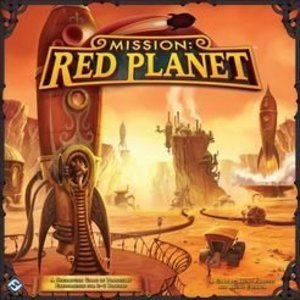
Mission: Red Planet (Second Edition)
Tabletop Game
With technology rapidly developing and the human population growing, Victorian-era Earth is in dire...
Boardgames SpaceGames MarsGames 2015Games GamesMadeBetterThanTheOriginal
Purple Phoenix Games (2266 KP) rated Jaipur in Tabletop Games
Jun 12, 2019
Congratulations! You have become one of the most powerful traders in the Indian city of Jaipur – nobody can strike a deal quite like you! Only the best merchant will have the privilege of trading directly with the Maharajah (the city leader), and that is definitely you! Or at least, it was until a new competitor showed up and started swiping your customers… Will you give up your position willingly? Of course not! Through cunning strategy, you can prove that you are still the best trader the city has to offer – so let the competition begin!
In Jaipur, you and your opponent take turns buying, trading, and selling goods and camels for money. Out-sell your opponent in two out of three rounds to become the greatest tradesperson! Collect sets of the same goods to maximize your earnings, and use your camels wisely in trades as you try to anticipate the market trends. On your turn, you can take one of four actions: 1. Take a single good from the market, 2. Take all of the camels from the market, 3. Exchange goods/camels from your hand for multiple goods in the market, or 4. Sell goods. What will your strategy be? Monopolize the market in a specific good, or dabble in all goods? Try to anticipate your opponent’s strategy and throw a wrench in their plans, or mind your own business? No matter what you choose, strategy is the key to success in Jaipur, so make it count!
Jaipur is probably my favorite two-player game to date. The rules are simple enough, the mechanics (card drafting and set collection) are straight-forward, and it requires enough strategy to make it a fun challenge! Since it is a specifically two-player game, everything you do directly impacts your opponent. On your turn, not only are you trying to think of the best move for you to make, but you must also be thinking of what your opponent is trying to accomplish. If a couple of rounds pass and I see my opponent picking up silver goods, I can probably guess they’re hoping to make bank by selling a complete set. So do I pick up the next silver I see on my turn? Or do I cash in the set of diamonds that I’ve been secretly picking up each round? My strategy is constantly changing based on what cards appear in the market at any given time, and that is what elevates this technically simple game for me!
The only grievance for me with Jaipur has to do with the market distribution. The market cards are re-shuffled at the end of each round, and sometimes the shuffling is not balanced. I have lost many rounds because I am forced to take low-scoring goods or camels from a saturated market, only to reveal high-scoring goods for my opponent to take on their turn. Ultimately, that is not an issue with the game, but an issue with my poor card-shuffling ability. If anything, I try to see it as a strategic challenge – how can I best use these lowly goods to balance out the better cards my opponent has picked up? Nothing is a given in this game, and the market can completely change in a single turn!
If you want a quick but engaging game, look no further than Jaipur. It’s a solid two-player game that deserves more love! Purple Phoenix Games gives it a 16 / 18 (Bryan hasn’t played it yet).
https://purplephoenixgames.wordpress.com/2018/12/28/jaipur-review/

Sniper Fury Target
Games
App
5/5 “Best graphics and as good as Call of Duty.” 5/5 “Fabulous game with breathtakingly...
Purple Phoenix Games (2266 KP) rated Corsairs of Valeria in Tabletop Games
Apr 2, 2021
Corsairs of Valeria is a dice rolling game in which players are racing to sail the Valerian islands and collect 6 treasure chests before any of the other pirate captains do. The first person to do so will claim the position of Commodore, and its associated status and power! To setup the game, each player receives a Ship board and ship meeple in their chosen color, 2 silver, and is randomly given a Captain card for the game. Each Captain card gives players a different special power to be used throughout the game. Ship boards have 2 dials to track Treasures and Grog. Set up the Start Island, shuffle and select 3 island Tracks to be placed above the Start, and finally end the lineup with Skull Island. Place 2 silver on Skull Island, and the game is ready to begin!
Each turn has four phases: Roll, Re-roll, Actions, End turn. First, gather all 5 dice and roll them. In the Re-roll phase, players may pay 1 Grog to re-roll any or all of their dice. You may re-roll as many times as you wish per turn, as long as you have Grog to spend. Once you are satisfied with your die rolls, you perform the actions shown on each die. Cursed dice must be executed first – for any dice that have a Skull on them, you must pay 1 silver to Skull Island per skull face shown. After Skulls are resolved, the rest of the die faces may be executed in any order you wish, as long as you resolve all the same symbols at the same time. The Grog symbol allows you to gain 1 Grog, the Silver symbol allows you to gain 1 silver, and the Map symbols allows you to move your ship meeple 1 space on the island track. Certain islands on the track provide additional resources once they are passed, so collect those as applicable. A Cannon symbol allows you to attack – either an opponent or a Merchant ship. To attack an opponent, you must roll at least 3 cannon symbols, and the chosen opponent then must give you all of their silver. To attack a Merchant ship, you must be sharing a space on the track with a Merchant ship, and you collect the resources printed on the ship for the number of cannons you spend to attack. After you have executed all of your dice actions, pass the dice to the next player and your turn is over.
At any point during the game, when you acquire 5 silver, you immediately trade them in for 1 treasure. Treasure is tracked on your ship board. The first player to reach 6 treasures wins the game! If, during the game, a player reaches Skull Island before 6 treasures have been claimed, a few things happen. First, that player receives all of the silver on Skull Island. Next, all ships are moved back to the Start Island, the 3 island Tracks are flipped to their opposite sides, and 2 silver are once again placed on Skull Island. The game continues in turn order, just now with new Tracks in play. If any player reaches Skull Island for a second time during the game, then the game ends once that player finishes their turn. In that case, if 6 treasures still have not been claimed, the player with the most Treasure wins.
I’m just going to start this off by saying that I love Corsairs of Valeria. Just like the other members of the Valeria family, this one checks off all the boxes that I love: great artwork, solid mechanics, and enjoyable immersion in the universe of Valeria. Let’s talk about gameplay first. At its core, Corsairs of Valeria is a dice rolling game, which is a luck-based mechanic. However, this game does provide options to employ strategies through the Captain powers and re-roll phase that give the player a little bit more control over what they can do each turn. Maybe you’re bad at rolling dice, but having the option to pay 1 Grog to re-roll any/all dice can get you out of a bad jam. Or maybe you have a powerful Captain ability that can really dictate your strategy and offer a path to success. It’s not just about the dice rolls, but about what you do to use those rolls to your benefit. So overall that just makes the game feel more engaging and enjoyable to me because I as a player have the ability to strategize each turn, I am not just at the mercy of the dice.
Another thing that I love about Corsairs of Valeria is that it is so simple, quick, and light to play. The rules seem a little involved at first, but ultimately here’s how a turn plays out: roll dice, re-roll if desired, perform actions/collect resources, end turn. The symbology is straight-forward, the turn phases are logical and concise, and there really is no down-time between turns. It requires strategy but still feels light enough to be a good palate cleanser or introductory game for newer gamers. And an awesome thing with quick games is that it is so easy to play several games in a row. I play at least 3 games of Corsairs before I decide to move on to the next game in my queue.
The consistency and continuity between all of the Valeria games is a huge plus for me. I love the artwork and appreciate that Daily Magic Games keeps bring back the same artist to create a cohesive universe! All of the Valeria games stand alone from each other, but the style and artwork make them all feel like a united entity.
Maybe I am a bit biased because VCK is my #1 game right now, but I think that Corsairs of Valeria is great. It is easily in my Top 20 games, and could continue moving up the list with more plays. It’s fast and light, yet strategic and engaging enough that it keeps me excited and energized throughout. There’s not a down moment when playing this game because ultimately, it’s a race! Keep an eye on the opponents, decide which strategy is best with your given die roll, and get a move on to get those treasures and best your rival captains. Purple Phoenix Games gives Corsairs of Valeria a sea-worthy 10 / 12.
Purple Phoenix Games (2266 KP) rated NMBR 9 in Tabletop Games
Jun 12, 2020
NMBR 9 is a tile-laying game of abstract strategy in which players are trying to accumulate the most end-game points. Setup is easy – just shuffle the deck of number cards, and you are ready to go! Here’s how you play. Every round, a card is drawn from the deck. Each player then takes the corresponding number tile and adds it to their arrangement following the specified placement restrictions. Those restrictions are as follows: tiles must be placed number-side up, tiles on the same level must be touching orthogonally, a tile placed on a level above other tiles must touch at least 2 tiles beneath it, and a tile placed on a level above other tiles must not have any gaps below it. Once everyone has placed their tile, a new card is drawn and play continues. The deck consists of 2 cards of each number (0-9), and once the deck runs out, the game ends and points are tallied. To count up your points, you multiply the number on each tile by the level on which the tile sits. The bottom-most level (on the table) is level 0, so any tiles there earn you no points. Let’s say you get an 8 tile on your 2nd level, so at the end of the game, that tile earns you 16 points. The highest score wins, so brush up on your multiplication tables!
Does NMBR 9 add up to everything you’d hoped for? Ok, bad pun. But really – how does this game hold up? For a game that is so easy to learn, it takes a lot of thought to play. The idea of tile-laying isn’t new, but because these tiles are all different shapes and have very specific placement restrictions, it takes this game to the next level – literally. The cards dictate the order in which tiles are played, so you are constantly adapting your strategy to fit the given tile into your array. One thing that helps make it a little easier to strategize is knowing that there are exactly 2 cards for every number in the deck. So as the game goes on, you can usually figure out which cards are left and try to set your grid up for maximum points. That being said, it still takes quite a bit more strategy than originally meets the eye. My first play was pretty brutal because I was not expecting to be that challenged!
The biggest drawback for me is that because of the abstract tile shapes and placement restrictions, it can be difficult to build a solid base upon which to earn yourself lots of points. Since you aren’t allowed to leave gaps under tiles, you really need to create as much unbroken space as possible to ensure that you can play any number of tiles on higher levels. That ultimately means that you have to sacrifice some tiles to your Level 0 (which scores no points) to eventually play tiles to any upper levels. If the bottom-most layer was Level 1, it would not feel like a waste to put, for example, a 9 on the table to create a platform for the next level. And another thing that can be rough at first is the scoring. Yeah yeah, simple multiplication isn’t that bad, but it still takes me a hot second to multiply everything and get it added up for my final score. Not a knock on the game necessarily, just a wake-up call for my lack of math skills I guess.
Overall, I think that NMBR 9 is a great game! It’s an easy game to learn, but definitely a tricky one to master. It is fast enough to play many times in a row, and I often find myself asking for one more play just to see if I can do better next time. All in all, it’s a great game, and I am so happy with this birthday gift! Purple Phoenix Games gives NMBR 9 a calculating 15 / 18.
Griffin (480 KP) rated Super Fight in Tabletop Games
Dec 14, 2018
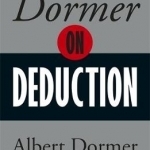
Dormer on Deduction
Book
The established classic on inferential reasoning in bridge. Deduction is the process of working out...

Through the Ages: A New Story of Civilization
Tabletop Game
You begin with a small tribe and the will to build a great civilization. Expand your farms and mines...

Arctic Scavengers
Tabletop Game
In the year 2097, the entire Earth was enveloped in a cataclysmic shift in climate, plunging the...

